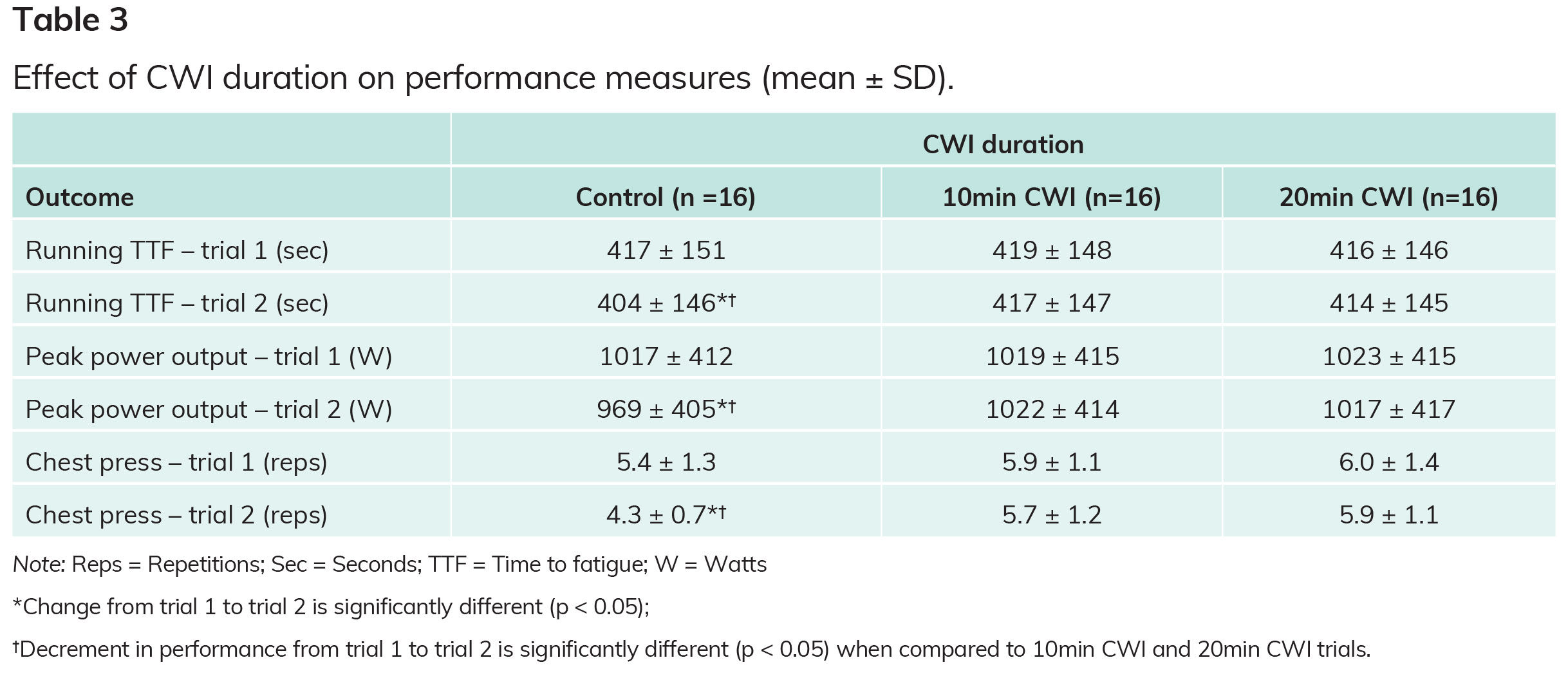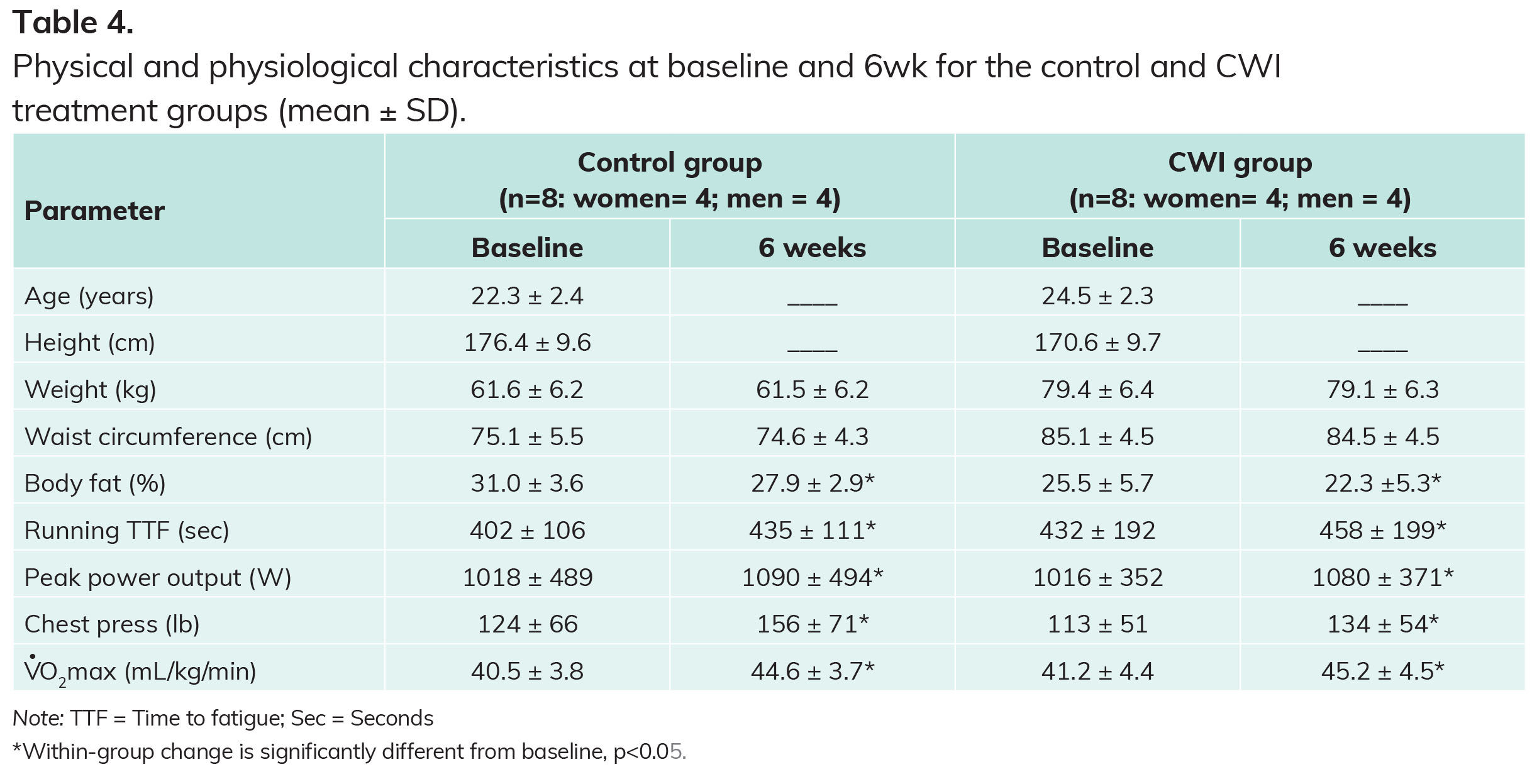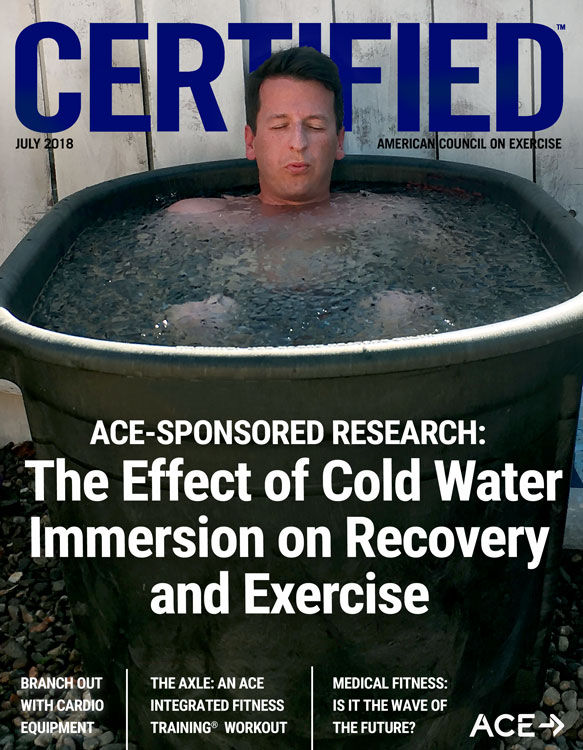
By Lance C. Dalleck, Ph.D., Elyza E. Montano, M.Sc., Sadie Carrillo, M.Sc., and Ryan M. Weatherwax, M.Sc., with Daniel J. Green
We’ve all seen videos of athletes giving post-game interviews from the discomfort of locker room ice baths. Does this recovery strategy really work, and can those benefits be enjoyed by typical gym-goers in addition to competitive athletes?
The mechanisms by which cold water immersion (CWI) aids in recovery are not yet well understood, though it is believed to reduce muscle fatigue and soreness (Versey, Halson and Dawson, 2013), as well as the overall time needed for recovery. Potential mechanisms include the fact that the cold water helps to decrease core and skin temperature, which increases heat-storage capacity, causes peripheral vasoconstriction and increases central blood volume. The increased vasoconstriction may aid in mitigating the inflammatory response in the tissue affected during the training bout. In addition, the added hydrostatic pressure on the body brought about by being submerged is thought to allow for a better flushing of metabolic byproducts (Ihsan, Watson and Abbiss, 2016)—more on this later.
ACE enlisted the help of Lance Dalleck, Ph.D., and his team of researchers in the High Altitude Exercise Physiology Program at Western State Colorado University to evaluate the acute and chronic effects of CWI on physical performance. The purpose of this study was threefold:
- To quantify the acute effects of CWI during different time periods of the recovery on exercise performance
- To determine whether there was a dose-response relationship between CWI duration and magnitude of improvement in recovery
- To quantify the chronic effects of CWI during recovery on training adaptations
For the purposes of this research, participants sat in baths containing water at 13 ± 0.5° C (approximately 55° F) up to their clavicles continuously for the target treatment time.
The Study
The researchers recruited 16 participants for this study, all of whom were sedentary, had not performed any resistance training in the previous six months, and were considered low-to-moderate risk. To quantify the acute effects of CWI during recovery on exercise performance (purposes 1 and 2 above), the participants completed four different testing sessions in random order, with at least 96 hours between sessions.
Each testing session consisted of workouts on back-to-back days, as the goal was to evaluate the effect that CWI after the first workout would have on performance during the second workout. As Dr. Dalleck explains, you can think of this in terms of athletes with competitions on consecutive days or exercisers performing workouts several days each week. Will using CWI as part of the recovery strategy after workout 1 enhance the person’s performance during workout 2?
During each workout, each participant performed a running time trial to fatigue at 70% of his or her second ventilatory threshold, a Wingate test (a cycle ergometer test that quantifies peak power output), and a chest press bout to fatigue at 80% of one-repetition maximum (1-RM). Proper warm-ups and cool-downs were performed before and after each type of exercise. The results of these workouts are referred to as “trial 1” in the tables below.
After the first workout, participants underwent one of the four recovery protocols listed below. They then returned 24 hours later to perform the same workout a second time (“trial 2”).
- Testing session 1 was the control session, with no CWI treatment.
- Testing session 2 featured 10 minutes of CWI immediately post-exercise.
- Testing session 3 included 10 minutes of CWI two hours post-exercise.
- Testing session 4 featured 20 minutes of CWI immediately post-exercise.
Sessions 1, 2 and 3 were used to quantify the acute effects of CWI during different time periods of the recovery. The researchers were trying to answer the question of whether the timing of when an athlete or exerciser underwent CWI had an impact on the effectiveness of this recovery method.
Sessions 1, 2 and 4 were used to investigate whether there was a dose-response relationship between CWI duration and the magnitude of recovery. In other words, how do the effects of 20 minutes of CWI compare to those seen after 10 minutes if the timing is the same (immediately post-exercise)?
To evaluate the chronic effects of CWI during recovery on exercise performance, the same participants were randomized into either a control group or a treatment group. Both groups completed six weeks of standardized aerobic exercise three days/week and resistance training two days/week.
All aerobic exercise was performed on a treadmill. The resistance-training program was a full-body workout consisting of 10 exercises. The intensity of those workouts progressed over the course of the six-week program (Table 1). Both groups were asked not to change their dietary habits.

Participants in the treatment group underwent 10 minutes of CWI immediately post-exercise following all training sessions, while those in the control group did not include CWI as part of their recovery strategy.
In addition to all participants performing a running time trial to fatigue, a Wingate test and 1-RM chest press, the following measures were obtained at baseline and after the conclusion of the six-week program: maximal oxygen uptake (VO2max), as measured via a graded exercise test on a treadmill, body composition, waist circumference and weight.
According to Dr. Dalleck, past research into the long-term effects of CWI is mixed, with some suggesting that it blunts favorable metabolic responses to exercise. This brings us back to the flushing of metabolic by-products mentioned earlier. While removing those by-products can aid in immediate recovery, some past research has suggested that doing so can actually inhibit the longer-term benefits of exercise. Collectively, the before-and-after data collected as part of this research was analyzed to determine whether regular CWI during recovery mitigates favorable training adaptations.
The Results
Remember, there were three distinct elements to this research.
- To quantify the acute effects of CWI during different time periods of the recovery on exercise performance
Performance in all three exercises—running to fatigue, Wingate test and chest press—for participants in the control group (i.e., those who did not use CWI as part of their recovery) decreased compared to both CWI groups. This includes those who underwent CWI for 10 minutes immediately post-workout as well as those who waited two hours post-workout (Table 2).

- To determine whether there was a dose-response relationship between CWI duration and magnitude of improvement in recovery
In this case, performance on all three exercises was preserved for both CWI groups (i.e., 10 minutes duration and 20 minutes duration immediately post-exercise) as compared to the control group (Table 3).

- To quantify the chronic effects of CWI during recovery on training adaptations
When it came to chronic use of CWI, the changes from baseline to after six weeks of training were similar between the control group and those who underwent CWI for 10 minutes immediately post-exercise (Table 4). In this case, a lack of difference is a decidedly positive finding, as this demonstrates that long-term use of CWI may not have a negative effect on the body’s response to training.

The Bottom Line
According to the research team, there are three take-home messages based on the findings from this study:
- Acute post-exercise CWI was a more effective recovery strategy when compared to no CWI at maintaining endurance and power performance.
- All acute post-exercise CWI strategies were equally effective at preserving performance.
- Chronic use of CWI during recovery did not diminish long-term training adaptations.
As Dr. Dalleck states, CWI is a time-efficient means of recovery that helps preserve performance from one workout or competition to the next. The fact that there was no dose-response relationship found (i.e., more is not better) means that the time commitment is minimal given the benefits. “If you have clients who are committed to their training programs,” he says, “CWI is a good investment of their time, especially when you consider the fact that only 10 minutes of CWI was required after each workout.”
In addition, because CWI was found to be equally effective two hours after training, clients don’t have to feel as though they have to run straight home from the gym, for example, in order to take advantage of this recovery strategy.
Finally, it is important to note that this research was conducted on untrained adults, not the athletic population that may commonly be associated with the use of this type of recovery strategy. CWI is effective not only for athletes competing on consecutive days, but also for exercisers who simply want to maximize their performance on back-to-back days in the gym.
Take a look at the considerable drop-off in performance in the control groups in each part of this research and it’s clear that recovery does not simply take care of itself. CWI may be an effective tool as you work to empower clients to derive the most benefit from their workout programs.
References
Ihsan M., Watson G. and Abbiss C.R. (2016). What are the physiological mechanisms for post-exercise cold water immersion in the recovery from prolonged endurance and intermittent exercise? Sports Medicine, 46, 1095-1109.
Versey N.G., Halson, S.L. and Dawson, B.T. (2013). Water immersion recovery for athletes: Effect on exercise performance and practical recommendations. Sports Medicine, 43, 1101-1130.






 by
by 








